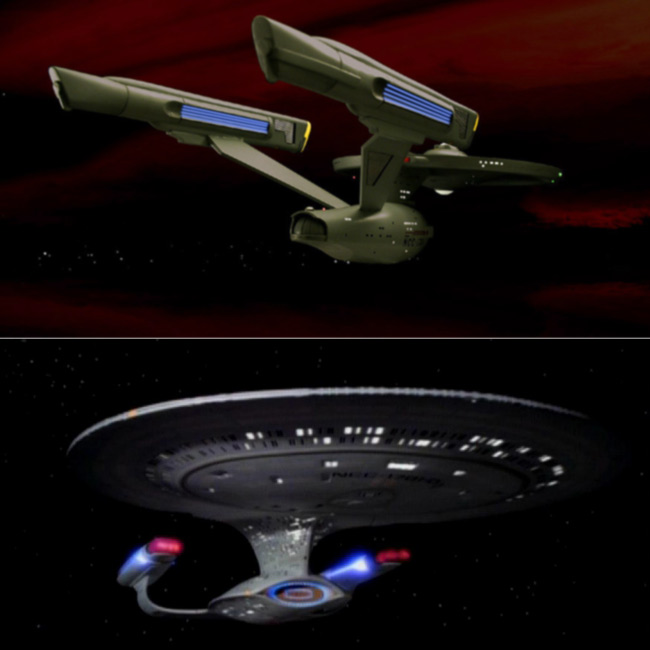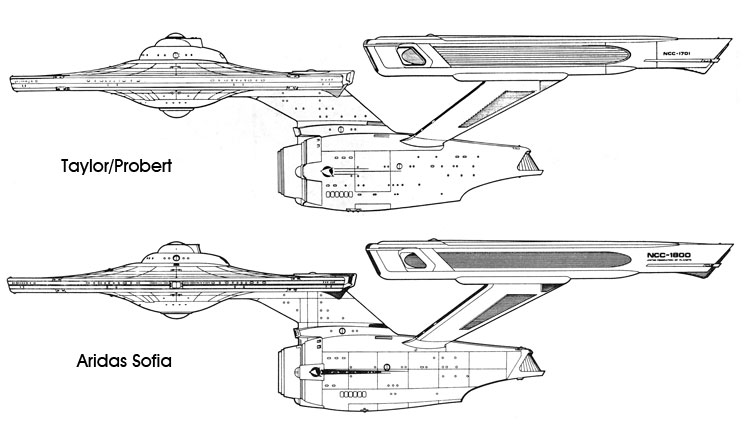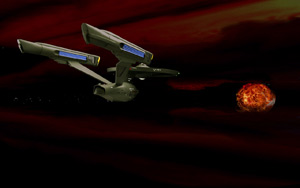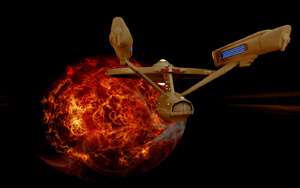-
Welcome! The TrekBBS is the number one place to chat about Star Trek with like-minded fans.
If you are not already a member then please register an account and join in the discussion!
You are using an out of date browser. It may not display this or other websites correctly.
You should upgrade or use an alternative browser.
You should upgrade or use an alternative browser.
Phase II Enterprise Study Model
- Thread starter Shaw
- Start date
- Status
- Not open for further replies.
I have a question for you?, if you have a photo
Of the ship in question. Why don't you just try to build a 55'
Model of the star ship and let's see what it will
Just look like ok?. This is my idea to you in your
Project.
See after I get more money I am going to do what I
Just told you to do. See my ship will be from 1966 TOS.
Of the ship in question. Why don't you just try to build a 55'
Model of the star ship and let's see what it will
Just look like ok?. This is my idea to you in your
Project.
See after I get more money I am going to do what I
Just told you to do. See my ship will be from 1966 TOS.
Umm, Spockboy, those pix are kinda too big. The board guidelines say we should keep them closer 640 wide. Usually it's best to post a smaller image and link to the mega sized ones for them's who wants.
Kenny, not everyone wants to make a house sized model. That's your dream.
I'm not clear on what these drawings are supposed to represent. Care to clarify?
I have a question for you?, if you have a photo
Of the ship in question. Why don't you just try to build a 55'
Model of the star ship and let's see what it will
Just look like ok?. This is my idea to you in your
Project.
See after I get more money I am going to do what I
Just told you to do. See my ship will be from 1966 TOS.
Kenny, not everyone wants to make a house sized model. That's your dream.
Maurice, I believe these drawings are of the TMP model as built and photographed for some early publicity images, but before water damage forced some repair/redesign, which altered the B/C deck/bridge area and provided an opportunity to redo the lower sensor dome. The one marked "Taylor/Probert" shows what was built and the one marked "Aridas Sophia" is one fans idealized representation of it.
Hope that helps!
--Alex
Hope that helps!
--Alex
I also liked his Constitution II.
The lighting effects for models may just have gotten easier
http://www.spacedaily.com/reports/P...sitive_displays_on_various_materials_999.html
If we combine our approach with 3D printing, we can print three-dimensional objects that display information and are touch-sensitive"
Delicate models like this other beauty from 1979 don't need the weight of wires, batteries, etc
https://www.flickr.com/photos/lazymodeler/sets/72157644653412223/.
The lighting effects for models may just have gotten easier
http://www.spacedaily.com/reports/P...sitive_displays_on_various_materials_999.html
If we combine our approach with 3D printing, we can print three-dimensional objects that display information and are touch-sensitive"
Delicate models like this other beauty from 1979 don't need the weight of wires, batteries, etc
https://www.flickr.com/photos/lazymodeler/sets/72157644653412223/.
Maurice, I believe these drawings are of the TMP model as built and photographed for some early publicity images, but before water damage forced some repair/redesign, which altered the B/C deck/bridge area and provided an opportunity to redo the lower sensor dome. The one marked "Taylor/Probert" shows what was built and the one marked "Aridas Sophia" is one fans idealized representation of it.
Hope that helps!
--Alex
Okay. Thanks.
Well here is a better idea then, if you can not do it
Then take the both photos to a blueprint co to resize it to a bigger size or a smaller size
Then. That if your computer can't do it then.
Then take the both photos to a blueprint co to resize it to a bigger size or a smaller size
Then. That if your computer can't do it then.
Why can't any body use the old starship like the ncc1701,
Photo?. Would any body like to build a 55' foot model of it for real and not the movie model of the ncc1701A?.
Photo?. Would any body like to build a 55' foot model of it for real and not the movie model of the ncc1701A?.
Actually, those nacelle domes are more like what it might have ended up like on screen... but more random than the TOS spinning blades.Awesome! Let's see it with some lights!
So I've been playing around in Photoshop with an idea for a setting for a series of images, and this is what I came up with...
Actually, I do tons of stuff with the original starship Enterprise... but this is a thread about the Enterprise that was going to be in the Star Trek II (known today as Star Trek: Phase II) TV series in 1978 had it not been converted into Star Trek: The Motion Picture. It is the topic of this thread, so we should try to stick to it.Why can't any body use the old starship like the ncc1701,
Photo?.
If you want to see something along the lines of the topic you suggested, start a thread on it.
But this model represents a lot of time devoted to research and building, and unlike most other previous attempts I've seen (and yes, I've seen them all), this one doesn't use post-Phase II elements or my artistic interpretations... this is pretty much all Jefferies (including a few elements that differed from how Price/Loos had them on the studio model).
You might not realize it, but this isn't the movie Enterprise... this is (to the best of my abilities) something unique representing how Jefferies' wanted the Enterprise to look in that never made TV series. I'll be going back and (with help from Brick Price) doing this again to do a representation of the studio model as it would have been finished.
Actually, I'm building a replica of the original 33 inch studio model from scratch, using plans I've drawn based on seven years of research (which includes two study models and three revisions of the plans)... and it is a super expensive undertaking.Would any body like to build a 55' foot model of it for real and not the movie model of the ncc1701A?.
A 55 foot version is something that you should talk to the Koch brothers about, because no one that frequents this forum could fund such an endeavor.
All that having been said, I don't want to run you out of this thread... so is there any on topic questions I could answer for you?
So, here's a question: would the glow of the engines have been blue, especially given they were going to probably shoot on bluescreen? I vaguely recall one of Jefferies sketches for some of the P2 ship development indicating a greenish light, but I could be mistaken.
In Jefferies' notes it said "requires chroma-key other than blue".
There were options to work around this as blue sensitive film wasn't the only type at the time (just the most common). One option (used in Superman) would have been to use an off blue color (blue-green) in the model and to go back and color correct it to blue later (which is what they did for Superman's costume).
But on screen, it was supposed to be blue... which was first put forward as a requested effect for the series upgrades to the 11 foot model back in 1965 (but deemed too expensive and risky to the nacelle, which wasn't originally designed for any type of lighting) and finally made it to screen with the Enterprise D.

Something else to keep in mind while looking at those two pictures... the Enterprise D and the Phase II Enterprise models are both about the same base color, so odds are the Phase II Enterprise would have had the same gray appearance on screen rather than the blue-green that it actually was (not that we got the true color of the original models in TOS either).
Also, I recently saw how elaborate the Enterprise D's nacelle domes were supposed to have been... and you couldn't make it out on the show. Had they tried something similar with the Phase II Enterprise we might have gotten something that looked as nice in person, but would have seemed underwhelming compared to the TOS's effect on screen.
I have a ton of notes and questions for Price when I finally have some time to go back to researching the filming model. This model is Jefferies' idealized version, there are a few differences between it and how the Price/Loos model was turning out. Though my impression is that the differences were largely due to Jefferies not being available to answer questions during the build (due to pressure from Michael Landon).
There were options to work around this as blue sensitive film wasn't the only type at the time (just the most common). One option (used in Superman) would have been to use an off blue color (blue-green) in the model and to go back and color correct it to blue later (which is what they did for Superman's costume).
But on screen, it was supposed to be blue... which was first put forward as a requested effect for the series upgrades to the 11 foot model back in 1965 (but deemed too expensive and risky to the nacelle, which wasn't originally designed for any type of lighting) and finally made it to screen with the Enterprise D.

Something else to keep in mind while looking at those two pictures... the Enterprise D and the Phase II Enterprise models are both about the same base color, so odds are the Phase II Enterprise would have had the same gray appearance on screen rather than the blue-green that it actually was (not that we got the true color of the original models in TOS either).
Also, I recently saw how elaborate the Enterprise D's nacelle domes were supposed to have been... and you couldn't make it out on the show. Had they tried something similar with the Phase II Enterprise we might have gotten something that looked as nice in person, but would have seemed underwhelming compared to the TOS's effect on screen.
I have a ton of notes and questions for Price when I finally have some time to go back to researching the filming model. This model is Jefferies' idealized version, there are a few differences between it and how the Price/Loos model was turning out. Though my impression is that the differences were largely due to Jefferies not being available to answer questions during the build (due to pressure from Michael Landon).
Well, as I said, it was perhaps one sketch that indicated a green color.
I'm not sure what you mean about "blue sensitive" as the blue was typically separated via filtering in the matte generating process.
As to the D: the 6-footer doesn't look gray on the blu-rays, especially in close shots. Also, Andy Probert says the color of ships was sometimes dialed down in post, so who knows what the P2 ship would have actually looked like on TV in 1978?
As to the D's nacelle caps, I showed that video to Andy and had never seen that before. He says it wasn't what he intended. My guess is that the producers just didn't like it and just never turned it on, just leaving the red glow.
I'm not sure what you mean about "blue sensitive" as the blue was typically separated via filtering in the matte generating process.
As to the D: the 6-footer doesn't look gray on the blu-rays, especially in close shots. Also, Andy Probert says the color of ships was sometimes dialed down in post, so who knows what the P2 ship would have actually looked like on TV in 1978?
As to the D's nacelle caps, I showed that video to Andy and had never seen that before. He says it wasn't what he intended. My guess is that the producers just didn't like it and just never turned it on, just leaving the red glow.
Okay... I guess we could talk about how mattes were made, which was using a special film emulsion sensitive to a specific color (blue, green and sometimes orange), it was chroma keyed to that color by the manufacturer of the film. When effects footage using that color as a background was exposed to the matte film, you ended up with white (clear) areas for that color and black every where else. Additionally, you could vary the matte by changing the intensity of the light projected through the original footage.I'm not sure what you mean about "blue sensitive" as the blue was typically separated via filtering in the matte generating process.
But all of this is done via the chemistry of the emulsion to make it sensitive to very specific colors. There wasn't a point and click process to select a color range to exclude or include, it was all done chemically on special film that was designed to work with a specific color.
Does that help explain it?
I'm well aware of how traveling mattes work. I poorly phrased my comment about the bluescreen. I meant to asking for clarification on what process you thought they'd be using, because there are a number of methods for generating the mattes, and color sensitive stock doesn't necessarily come into play, since many times mattes were generated via filters when printing to high-con b&w stock rather than using a high-con stock with a particular color sensitivity.
(For those who are interested, here's a pretty good explanation of how bluescreen worked (LINK) from the 60s up to the digital age. I set the in point to right where the discussion of that process starts, but the whole video is pretty interesting. )
(For those who are interested, here's a pretty good explanation of how bluescreen worked (LINK) from the 60s up to the digital age. I set the in point to right where the discussion of that process starts, but the whole video is pretty interesting. )
I hope Maurice's intensions weren't to shut me down. My time is too limited right now to play internet games and I only took the time to respond to Maurice's question because I assumed it was an honest one. I was walked through the process first hand back in the 80's and with limited time I gave him the best answer I could.I remember once some guy shut me down about my misconceptions about optical matting and I think (could be remembering wrong) it was this guy...
I'm happy to share information, but I don't have time for games right now.
I'd like to believe that Maurice's intensions were honest and honorable, but I can't afford the time if it was all intended to try to play one-upmanship.
- Status
- Not open for further replies.
Similar threads
- Replies
- 25
- Views
- 10K
- Replies
- 87
- Views
- 20K
If you are not already a member then please register an account and join in the discussion!














